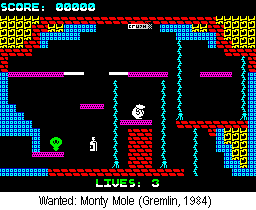|

By Lloyd Mangram
October
1984
Issue 9
|
|
Oliver's
Ziggy cover was amongst the most popular he produced.
It was really the first CRASH cover definitely promoting
a specific game, Fantasy's Backpacker's Guide To
The Universe. Here was an opportunity to use his
imagination to bring to life objects, characters and
weird aliens involved in a game that no-one had yet
seen, all from written details offered in the prerelease
description. The result is a powerful picture which,
ironically, probably informed more readers of what hero
Ziggy was like than anything Fantasy themselves put
out.
|
By its ninth edition, the effect CRASH was beginning to have
on the software industry was, in turn, being reapplied to
its staff. Roger Kean had already been horrified a couple
of months earlier at Micromania's concern when they were informed
by the most powerful software distributor of the time that
unless a game achieved better than 65% in CRASH it wouldn't
be accepted for distribution. Now, proof sheets of CRASH reviews
were being requested by retail chains to see whether a game
was worthy of shelf space.
It put pressure on the reviewing team - Matthew, Chris Passey
and Robin Candy - because software houses wanted to present
unfinished games to discover what the reviewers would like
to see improved, so that the game had a chance of becoming
a CRASH Smash. Some may have considered that a visit with
the personal touch would influence the team by putting it
on the spot when it came to making an impartial judgement.
If so, as many were to be disappointed by Matthew's outspoken
opinions and Robinís downright stubbornness. Now another young
reviewer had appeared (and undergone the ritual photograph
pushing CRASH T-shirts on the Hotline page). He was Ben Stone,
from nearby Tenbury, and he was as daunting in his opinions
as the others, despite his newcomer status.
The Ziggy cover did little to help. That kind of coverage
was eagerly sought by companies desperate to convince shops
that their game was about to sell in its tens of thousands,
and since it seemed that Fantasy got a cover with apparently
no trouble, Roger found himself inundated with calls suggesting
ideas that would have kept CRASH in covers until the 1990s!
As a consequence, for the remainder of the year Oliver avoided
game-linked cover paintings.
One of the questing visitors was Angus Ryall of Games Workshop,
but he stayed longer than most, becoming our strategy columnist
for the new Frontline. Another was Steve Wilcox of newly-formed
Elite, who brought with him the oddly-named Kokotoni Wilf.
Over several days both Matthew and Robin debated with Elite's
programmers on minor improvements before pronouncing themselves
satisfied, but Steve may have been disappointed that Kokotoni
Wilf still missed being a Smash.
 In
fact Smashes were a bit thin - the pre-Christmas period was
looming and software houses were holding back, apart from
Gremlin Graphics. They'd scored quite a coup with TV news
coverage of their 'mining' game which caricatured Arthur Scargill,
then very much in the news because of the national miners'
strike. Wanted: Monty Mole was a surefire Smash, capturing
all the addictivity of Jet Set Willy and offering loads
of new puzzling problems to solve. In
fact Smashes were a bit thin - the pre-Christmas period was
looming and software houses were holding back, apart from
Gremlin Graphics. They'd scored quite a coup with TV news
coverage of their 'mining' game which caricatured Arthur Scargill,
then very much in the news because of the national miners'
strike. Wanted: Monty Mole was a surefire Smash, capturing
all the addictivity of Jet Set Willy and offering loads
of new puzzling problems to solve.
Within days we achieved a cheat mode for Monty Mole
and began preparing the map for a future issue. It was a typical
late-afternoon situation: Ben (school over for the day) playing
the game to reach every screen one by one, Roger sitting sketchpad
in hand roughing out the screens for Oliver to fill in the
detail later, Matthew in another corner alternating between
reviewing and making halftone pictures for David Western in
the layout room, Robin sorting through mail ready for me to
start the Forum. The jokes about Robin taking over my desk
were no jokes!
If this paints a suspiciously cosy picture of contentment
and smacks of nostalgia for its own sake, don't be fooled
- it was hard work for the small team. Within a few short
months a massive expansion was about to take place and the
coming changes would sunder the simpler comforts we then enjoyed.
The first indication of change was the arrival of a black
Apricot xi computer. For Roger Kean, at least, the days of
typewriters, paper and Tipp-Ex were over.
|